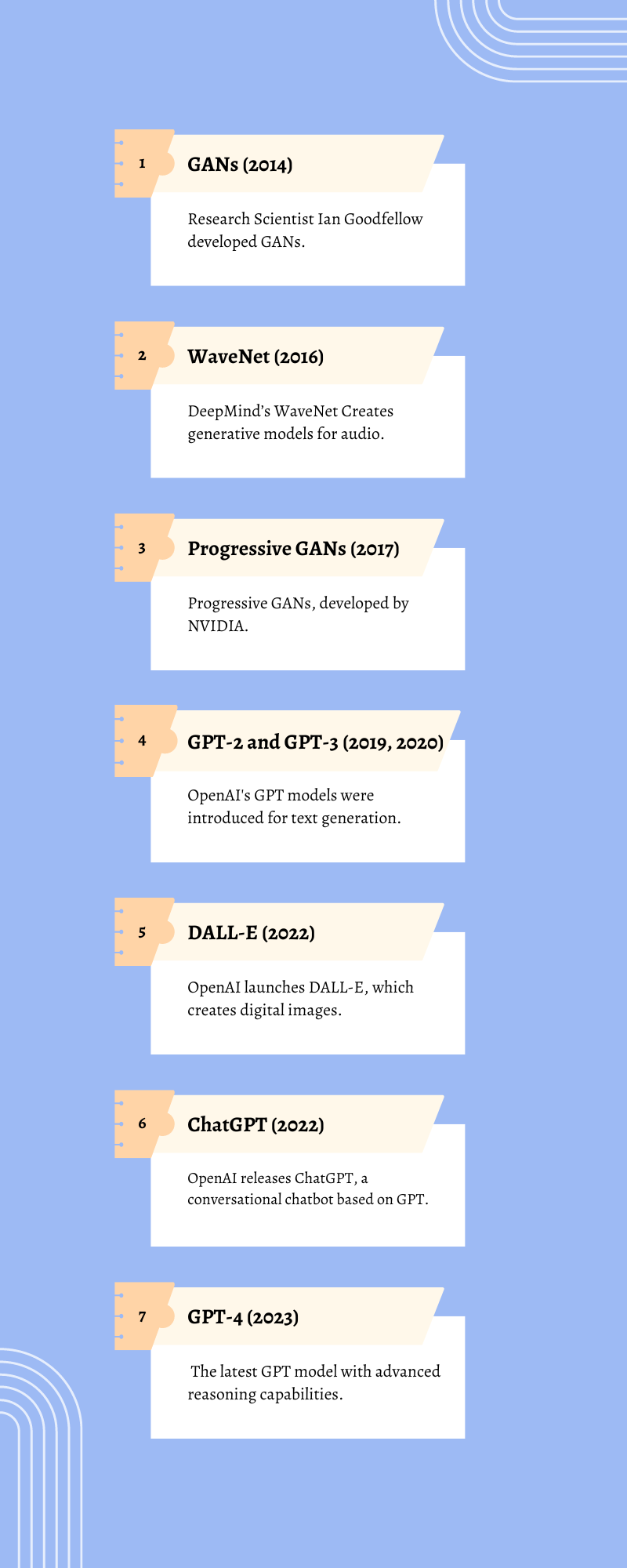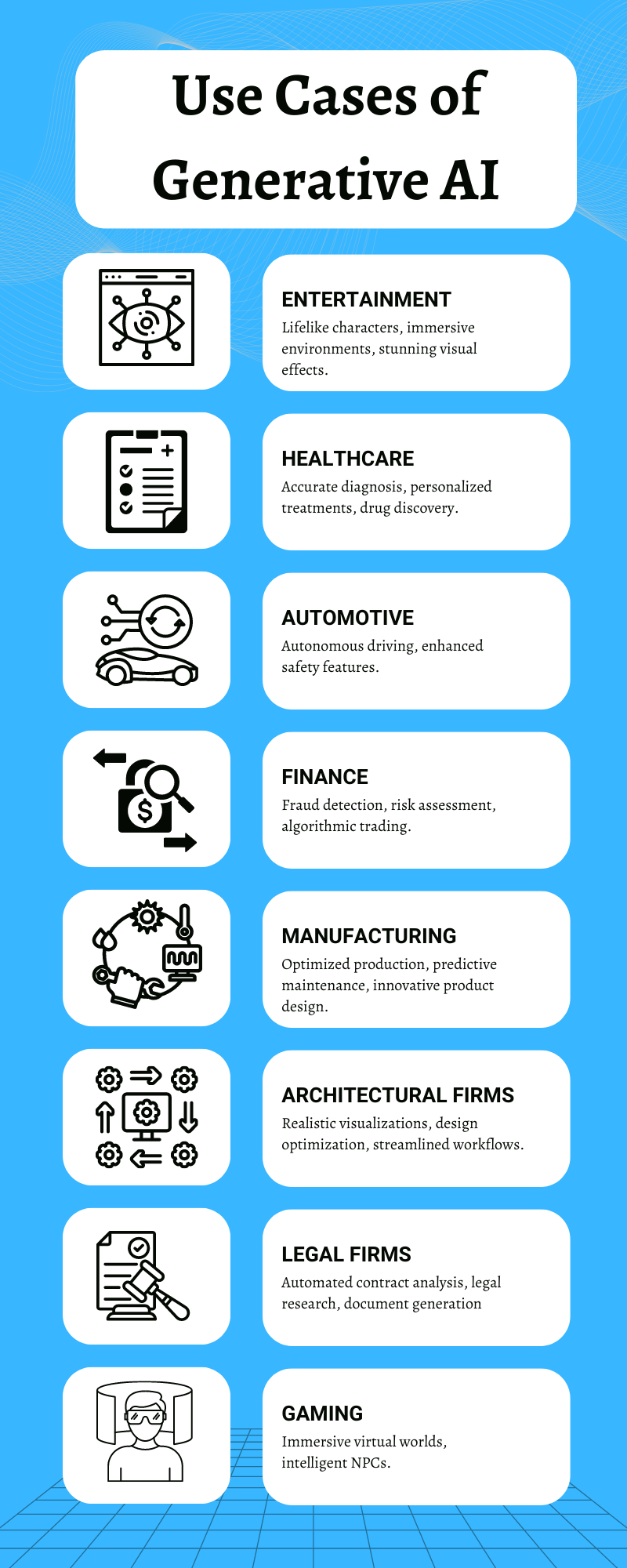You’ve probably heard of generative artificial intelligence (AI) tools like ChatGPT, Bard, and DALL-E by now. They’re gaining much attention since anybody can use them to quickly produce content, from emails to code functions to artwork.
Beyond binary logic, the idea of generative AI leads us on a path where AI is not just an executor of duties but also an innovator. Artificial Intelligence has the potential to be a creative partner that can provide unique outputs to encourage, help, and even astound humans.
Whether you’re an experienced techie or a curious explorer, generative AI development is where algorithms intertwine and produce remarkable new outcomes. It’s a world where creativity and coding coexist, and the only boundaries are the depths of human imagination.
This innovative branch of AI opens up a world where machines can reflect some human-like creativity, bringing us closer to the vision of truly intelligent systems. Therefore, understanding generative AI’s definition, applications, and who it is used by is crucial, given its potential to revolutionize content production across various sectors.
What is Generative AI?
Generative AI is a sub-component of artificial intelligence that focuses on creating machines capable of generating new and original content. In generative AI development services, Algorithms and neural networks are used to create new outputs like images, music, text, animation, 3D models, or even complete virtual worlds by learning patterns from existing data.
The Evolution of Generative AI
You should note that the technology is not entirely new. In the 1960s, MIT professor Joseph Weizenbaum introduced generative AI and developed the first chatbot, Eliza, which stimulates interactions with a psychotherapist. Numerous significant innovations have contributed to the evolution of Generative AI and opened new chapters in generative software development.

What is Generative AI Utilized For?
Despite the hoopla around new generative AI tools like ChatGPT or the new Bing, there is much more to generative artificial intelligence than any particular framework, project, or application.
By responding to natural language prompts, generative AI creates fresh or innovative outputs such as an image, text, or audio.
Generative AI models, for example, be used for:
1. Language Processing
Natural language processing (NLP) empowers machines to understand and interpret human language. From sentiment analysis to language translation, NLP enables advanced text processing, making interactions between humans and machines more seamless and intuitive.
Text is the most sophisticated domain and the foundation of many generative AI models. Large language models (LLMs) are one of the most well-known language-based generative models. Large language models are used for a broad range of activities, including creating essays, writing code, translating, and even deciphering genetic sequences.
2. Audio Generation
Music, audio, and speech generation are also emerging fields in generative AI. Examples include models that recognize things in films and produce corresponding noises for various video materials, develop songs and fragments of audio with text inputs, and even produce original music.
3. Visuals
One of the most well-known use cases of generative AI is in the field of visuals. It includes producing avatars, videos, graphs, and other illustrations in 3D. There are methods for editing and adjusting generated graphics and flexibility in developing images with various aesthetic trends.
4. Synthetic Data Generation
Synthetic data generation is constructive for training AI models when actual data is unavailable, restricted, or just insufficient to handle all possible corner cases accurately. Developing synthetic data using generative models is one of the most effective ways to address many organizations’ data challenges. An AI development company can train and generate synthetic data to create unique outputs.
How Does Generative AI Work?
Generative AI models use neural networks to recognize the patterns and structures within existing data to create fresh and unique content.
The capacity to use several learning methodologies, such as unsupervised or semi-supervised learning for training, is one of the breakthroughs of generative AI models. Organizations may now use a significant volume of unlabeled data more rapidly and efficiently to build foundational models.
As the name implies, foundation models can serve as the base for AI systems capable of carrying out various tasks. GPT-3 and Stable Diffusion are some examples of foundation models that let users take advantage of the language.
What Are The Key Requirements For Generative AI Development?
To build AI models, a generative AI company uses the following three criteria that must be met to be effective:
-
Quality
High-quality generation outputs are essential, especially for applications that interact directly with consumers. Poor speech quality, for instance, makes it challenging to interpret speech.
-
Diversity
An excellent generative model preserves generation quality while capturing the minority modes in its data distribution. As a result, the taught models have fewer unintended biases.
-
Speed
Many interactive apps demand fast generation, such as real-time image editing, for content development workflows.
How to Build Generative AI Models?
There are various generative model types, and combining the advantages of each makes it possible to build even more potent models.
Below is a breakdown:
-
Generative Adversarial Networks (GANs)
GANs, or generative adversarial networks: One of the most popular generative AI models is called GANs, using two distinct neural networks: a generator and a discriminator.
The generator network creates new data from a random noise signal, such as images or sounds. At the same time, the discriminator is trained to differentiate between actual data from the training set and the data produced by the generator.
-
Large Language Models
LLMs are machine learning models that process and produce natural language text. The accessibility of enormous volumes of text data from sources like books, websites, and social media posts has been one of the most crucial developments in developing large language models.
Then, the data can be utilized to train models that can anticipate and produce natural language responses in various contexts. Large language models have numerous real-world uses, including in chatbots, virtual assistants, and text generators like ChatGPT.
-
Diffusion Models
Diffusion models are generative models that excel at capturing complex data distributions. They work by iteratively applying a diffusion process, gradually transforming a simple initial distribution into the desired complex target distribution.
Diffusion models have shown promising results in tasks such as image synthesis, denoising, and inpainting, making them a powerful tool in generative AI.
-
Variational Autoencoders (VAEs)
These models are comparable to GANs using encoders and decoders from separate neural networks. It is possible to create new data that is identical to the original data by using VAEs by compressing enormous amounts of data into a smaller form. An artificial intelligence development company uses VAEs to create images, videos, and audio generation quickly.
-
Transformer-based models
These models are very effective at natural language processing tasks like machine translation, language modeling, and question answering. Their neural networks operate by learning context and meaning through tracking relationships of sequential data.
Transformer-based models have been extended for similar tasks involving sequential data modeling, such as image recognition, and have been utilized in well-known language models, such as GPT-4 (Generative Pre-trained Transformer 4).
Tech Stack Required To Build Generative AI
A comprehensive generative AI tech stack is required to build AI models. Here are some key components:
| Programming Languages | Python (TensorFlow and PyTorch) |
| Generative Models | GANs, VAEs |
| GPU Acceleration | Graphics Processing Units (CUDA and cuDNN) |
| Data Processing | Pandas and NumPy |
| Image Processing | OpenCV and PIL |
| Cloud Platforms | Amazon Web Services (AWS), Microsoft Azure, or Google Cloud |
| Model Deployment | TensorFlow Serving, Flask, or FastAPI |
| Version Control | GitHub or GitLab |
| Experiment Tracking | TensorBoard, MLflow |
By leveraging this tech stack, generative AI developers can efficiently build, train, deploy, and iterate on Generative AI models, unleashing their creativity and pushing the boundaries of artificial intelligence.
How Does Generative Artificial Intelligence Help Transform Various Industries?

Unlock the transformative power of Generative AI as we delve into how it revolutionizes industries.
1. Entertainment
AI development service creates realistic virtual characters, enhances visual effects, and automates content creation for movies, games, and animations.
2. Healthcare
It aids in medical image analysis, drug discovery, and personalized treatment plans, revolutionizing disease diagnosis and patient care.
3. Automotive
Artificial intelligence development services improve autonomous driving, vehicle design, and predictive maintenance, enhancing road safety and efficiency.
4. Finance
It enables fraud detection, risk assessment, and automated trading, empowering financial institutions with data-driven decision-making and streamlined operations.
5. Manufacturing
Generative AI optimizes production processes, predictive maintenance, and product design, driving innovation and efficiency in manufacturing industries.
6. Architectural Firms
It generates realistic 3D models, automates design optimization, and facilitates virtual walkthroughs, revolutionizing architectural visualization and design processes.
7. Legal Firms
App development services for generative AI assists in contract analysis, legal research, and document generation, enhancing efficiency and accuracy in legal workflows.
8. Gaming
It generates immersive game environments, intelligent non-player characters (NPCs), and dynamic storytelling, transforming the gaming experience into a truly interactive and engaging adventure.
What Are The Benefits of Generative AI Development?
Numerous business domains can benefit significantly from the application of generative AI. Existing content can be easier to perceive and comprehend, and new content can be generated automatically.
You can hire augmented reality developers who are exploring how generative AI can enhance current workflows to rewrite workflows to take advantage of the technology completely. The following are some potential advantages of implementing generative AI:
- To automate the manual content creation procedure.
- Lowering the effort required to reply to emails.
- Increasing the responsiveness to particular technical inquiries.
- Constructing accurate portraits of people.
- For making a logical narrative out of complex information.
- Streamlining the production of content in a specific style.
What are ChatGPT, Bard, And DALL-E?
Let’s learn about ChatGPT, Bard, and DALL-E—three groundbreaking creations that redefine what’s possible in chat, poetry, and image generation.
1. ChatGPT
The GPT-3.5 implementation by OpenAI was the foundation for the AI-powered chatbot that shook the world in November 2022. OpenAI has enabled interaction and improved text responses through an interactive chat interface with feedback. On March 14, 2023, GPT-4 was released. The history of a user’s chat using ChatGPT is incorporated into the program’s output, imitating a real conversation.
2. Google Bard
The LaMDA series of large language models was the foundation for Google Bard. Since then, Google has introduced a new version of Bard based on PaLM 2, its most sophisticated LLM, which makes user queries answered by Bard more quickly and visually.
3. DALL-E
It is an example of a multimodal AI application that recognizes relationships across several media, such as vision, text, and audio. DALL-E was trained on a large data set of photographs and their related written descriptions. In this instance, it links verbal meaning to visual components.
In 2021, it was created utilizing OpenAI’s GPT implementation. Dall-E 2, a second, more advanced version, was launched in 2022. It allows users to create imagery in many styles driven by user prompts.
Difference Between ChatGPT vs. Bard
Data source
ChatGPT is trained on a massive dataset of text and code, while Bard is trained on a dataset of text and code and real-time information from the internet. It means that Bard can access the latest information and provide more up-to-date answers to questions.
Large language models (LLMs)
ChatGPT uses the Generative Pre-trained Transformer 4 (GPT-4), while Bard uses the Language Model for Dialogue Applications (LaMDA). LaMDA is a newer and more powerful LLM than GPT-4, so Bard can generate more complex and nuanced text.
Conversational AI capabilities
ChatGPT is better at generating paragraphs and summaries, while Bard is better at conversations. It is because Bard is able to use context from previous conversations to generate more natural and engaging responses.
User interface
Bard has a more user-friendly interface than ChatGPT. The text is formatted more neatly, and there are more options for interacting with Bard, such as the ability to edit your questions after you ask them.
Availability
ChatGPT is available to the public while Bard is still in beta testing. Bard is not yet as widely available as ChatGPT, but it will likely become more widely available.
| Features | ChatGPT | Bard |
| Data source | Text and code | Text, code, and real-time information from the internet |
| LLM | GPT-4 | LaMDA |
| Conversational AI capabilities | Better at generating paragraphs and summaries | Better at conversations |
| User interface | Less user-friendly | More user-friendly |
| Availability | Publicly available | Beta testing |
What Are Some Popular Examples of Generative AI Tools?
Generative artificial intelligence tools exist for diverse modalities, like text, imagery, music, code, and voices. Some popular AI content generators to explore include the following:
- Text Generation-GPT, AI-Writer, Jasper, and Lex.
- Image generation- Dall-E 2, Midjourney, Pix2Pix, StyleGAN, Stable Diffusion
- Voice synthesis- Descript, Listnr, Podcast.ai.
- Music generation- MuseNet, Amper, Magenta, Dadabots
- Code generation-GitHub Copilot, Tabnine, CodeStarter, Codex
What The Future Holds For Generative AI?
The extraordinary breadth and simplicity of ChatGPT have demonstrated outstanding potential for the mainstream adoption of generative AI. However, these early implementation challenges have sparked research toward more effective techniques for identifying text, images, and video produced by AI. For creating more dependable AI, businesses will also develop better tools for tracing the data source.
Future research and development of more robust generative AI capabilities for text, images, video, 3D content, medicines, supply chains, logistics, and business processes will also be sped up with the support of mobile app developers.
The quality of grammar checkers will increase. More beneficial recommendations will be readily included in workflows via design tools. To assist with training, training tools will be able to discover the best automatic practices in the organization. And these are just a few examples of generative AI that will change our work.
How Can SparxIT Help in Building Next-Gen Generative AI Solutions?
Are you prepared to explore the endless potential of cutting-edge generative AI solutions? Look no further than SparxIT. We specialize in developing robust AI solutions to boost your company’s performance.
We use the power of generative AI to transform industries, developing intuitive picture synthesis algorithms and immersive virtual worlds. You can hire machine learning developers to meet your business requirements, ensuring seamless integration and outstanding outcomes.
Contact SparxIT today and let us help you build the next-gen AI solutions that will set you apart from the competition. Together, we’ll shape the future of your industry.

Want to build the future of innovation with Generative AI Development?
Frequently Asked Questions
How can Generative AI benefit my specific industry or business niche?







Generative AI can benefit your specific industry or business niche by automating tasks, improving product design, enabling personalized recommendations, and optimizing resource allocation.
Can you provide examples of successful real-world applications of Generative AI?












Successful real-world applications of Generative AI include generating photorealistic images, creating virtual characters for entertainment, enhancing natural language processing, and aiding in drug discovery.
Are there any legal implications to be aware of when deploying Generative AI systems?












Legal implications when deploying Generative AI systems include data privacy, intellectual property rights, ethical considerations, and compliance with regulations such as GDPR or CCPA.
How long does it take to create Generative AI model?












The time to develop Generative AI model varies based on complexity, data availability, and expertise. Depending on the specific project requirements, it can range from 5 to 7 months.
How much does it cost to build a Generative AI Model?












The cost of building a Generative AI model depends on factors like the project’s complexity, data requirements, infrastructure, and team expertise. Prices can range from thousands to millions of dollars, reflecting the resources involved in development, data acquisition, and computational power.




